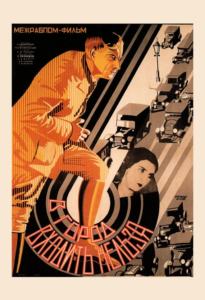An homage is an imitation of another work. At first glance, it may seem like an homage is a lesser copy, but it pays tribute to and honors the source work. Homage is a great way to use other filmmakers’ styles and content to crystallize your unique voice as a filmmaker. Explore the art of paying tribute in our article on homage.

What Is Homage?
Homage, frequently used as an inspiration in art, is a “dedication to” or a “show of respect” for something or someone. The type of homage and the piece of art (literature, poetry, theater, or film) can differ. It was originally a French term for claiming loyalty to a Lord, but it often applies whenever an artist references another artist. An homage can be as obvious or subtle as the artist prefers. This leads to results that are either easily spotted or hardly noticed.
What is Homage in Art?
Homage, frequently used as an inspiration in art, is a “dedication to” or a “show of respect” for something or someone. The type of homage and the piece of art (literature, poetry, theatre, or film) can differ. It was originally a French term for claiming loyalty to a Lord, but it often applies whenever an artist references another artist. An homage can be as obvious or subtle as the artist prefers. This leads to results that are either easily spotted or hardly noticed.
What is Homage In Cinema?
In cinema, homage refers to a deliberate and respectful tribute or reference made by a filmmaker to another film, director, actor, or element of the cinematic world. Homages can take various forms, including visual, thematic, or narrative references. Filmmakers use homage to pay their respects, acknowledge influences, or create a sense of nostalgia for the audience. Homage is a way for filmmakers to celebrate the works and artists that have had a significant impact on the history of cinema, allowing them to connect their creations with the rich tapestry of cinematic history and culture.
What Is a Homage Shot?
An homage shot in cinema is a deliberate and often subtle reference to a specific film, director, actor, or cinematic element that pays tribute to or acknowledges the influence of a particular work or artist. These shots are crafted with great attention to detail, mimicking the visual style, composition, or iconic moments from the source of inspiration. Homage shots evoke a sense of recognition and nostalgia among cinephiles while conveying the filmmaker’s respect and appreciation for the original work. They serve as a form of cinematic homage, bridging the past with the present and adding depth to a film’s storytelling by drawing on the rich history of cinema.
What is the Purpose of Homage?
The purpose of homage in cinema serves several important functions:
Respect and Acknowledgment
Filmmakers use homage to pay respect to the works, directors, actors, and cinematic elements that have influenced their creations. It’s a way to acknowledge the impact of those who came before and paved the way in the film industry.
Nostalgia
Homage can create a sense of nostalgia for the audience, invoking feelings of familiarity and fondness for classic films or iconic moments. This emotional connection can deepen the audience’s engagement with the current film.
Cultural and Cinematic References
Homage can be a form of intertextuality where filmmakers reference well-known cultural or cinematic touchstones. This can add depth to a film’s narrative and resonate with viewers who are familiar with the references.
Educational and Appreciation
Homage can serve as a teaching tool, introducing new generations of film enthusiasts to classic works and influential figures in cinema. It can encourage viewers to explore the rich history of filmmaking.
Strengthening Themes
When done effectively, homage can reinforce the themes and messages of a film by drawing parallels with earlier works or ideas. It adds layers of meaning and depth to the storytelling.
Creative Inspiration
Filmmakers may use homage as a source of creative inspiration, building upon the innovations and techniques of past masters while adding their unique perspective.
Building Connections
Homage can create a sense of community and connection among filmmakers and film lovers. It’s a way for creators to communicate their shared passion for cinema and engage in a dialogue with their audience.
The purpose of homage in cinema is to pay tribute, evoke nostalgia, reference cultural and cinematic touchstones, educate, strengthen themes, inspire creativity, and build connections within the film community. It enriches the cinematic experience and adds meaning to the storytelling while celebrating the art form’s rich history.
What Is the Difference Between Homage And Plagiarism?
Homage and plagiarism are two distinct approaches to referencing and incorporating the work of others in creative endeavors. Homage is a deliberate and respectful acknowledgment of the influence of a particular work, artist, or element in a new creation. It pays tribute, often with a fresh and creative twist, and is intended to celebrate the source of inspiration while adding to the overall work’s depth and meaning. Plagiarism, however, involves directly copying or imitating another’s work without proper attribution or permission. It lacks the respect, transformative quality, and creative intent found in homage and is considered unethical and illegal, as it involves passing off someone else’s work as one’s own. The key distinction lies in intention and respect; homage is a form of artistic appreciation and innovation, while plagiarism involves unethical and unauthorized copying.
When To Pay Homage?
Homage is typically paid in creative works when the creator wishes to acknowledge, celebrate, or draw inspiration from the work, artists, or elements that have influenced their creation. Some common situations when homage may be appropriate include
Influential Works
When a filmmaker or artist is inspired by a classic film, book, artwork, or artist and wants to pay tribute to the impact and influence of that source.
Genre Conventions
Homage is often used to reference or playfully subvert genre conventions or clichés in a way that engages the audience’s familiarity with those tropes.
Iconic Moments
Filmmakers may pay homage to iconic scenes or moments from cinema history to evoke nostalgia or reinterpret them in a fresh context.
Homage to Filmmaking Masters
Paying tribute to legendary directors, actors, or other artists is common, showcasing their contributions to filmmaking.
Cultural and Historical References
When a film or work is set in a particular era, location, or cultural context, homage may reference or honor aspects of that time or place.
Creative Innovation
Filmmakers may use homage as a source of creative inspiration, building upon the innovations and techniques of past masters while adding their own unique perspective.
Character Development
In some cases, characters in a film may pay homage to iconic figures or works, revealing aspects of their personality or backstory.
Respect for Pioneers
Filmmakers may pay homage to those who pioneered or made significant contributions to the industry, recognizing their lasting legacy.
In essence, homage is a way for creators to celebrate their medium’s rich history and diversity while adding depth and meaning to their work. It’s a creative gesture that showcases respect for the past and the intention to engage with and contribute to the ongoing conversation in art and entertainment.
Types of Homage in Hollywood
Acting Homage
Acting homage refers to an actor’s deliberate and respectful tribute or reference to another actor’s performance, style, or iconic roles in their own acting work. This can manifest in various ways, such as adopting specific mannerisms, vocal inflections, or gestures associated with the referenced actor. Acting homage is often done to celebrate the influence and impact of a particular actor or to pay respect to their legacy in the world of cinema or theater. Actors may incorporate elements of acting homage into their performances to evoke a sense of nostalgia, entertain audiences familiar with the referenced work, or demonstrate their versatility and range by emulating the acting styles of renowned performers. This practice can add depth and layers to a character’s portrayal and contribute to the overall storytelling by drawing on the rich history of acting in film and theater.
Scripted Homage
A scripted homage in the context of filmmaking and screenwriting refers to a deliberate and planned reference or tribute to a specific scene, dialogue, character, or element from another film or work within the script of a new production. This reference is written into the script by the screenwriter or director to pay homage to, celebrate, or acknowledge the influence of the source material. Scripted homages can take various forms, including recreating a famous scene with a fresh twist, using iconic dialogue or catchphrases, or incorporating characters with clear parallels to those from the source material. The purpose of a scripted homage is to engage the audience, create a sense of nostalgia, and add depth to the storytelling by drawing on the rich history of cinema.
Scripted homages are a deliberate and creative tool to bridge the past with the present, celebrate the works and artists that have made an impact, and connect the new production with the cinematic heritage. Cinephiles often appreciate them and recognize and enjoy these references in films and television shows.
Pixar Movies and Homage
Pixar, the renowned animation studio, is known for using homage in its films. The studio frequently pays tribute to classic films, popular culture, and various elements of cinema and storytelling. These homages can be visual, thematic, or narrative references that add depth and entertainment value to Pixar’s movies.
Here are a few examples of Pixar’s use of homage:
Toy Story Series

The “Toy Story” films are homages to classic toys, movies, and pop culture. For example, Buzz Lightyear is a homage to science fiction, space exploration, and action figures.
Toy Story 4 | Official Trailer
[Jwatchnow link=”https://www.amazon.com/Toy-Story-Tim-Allen/dp/B005ZMV2EQ/ref=sr_1_2?crid=2OL1W96S9KWZR&keywords=toy+story&qid=1697452800&sprefix=toy+story%2Caps%2C399&sr=8-2″ watchon=”Amazon”]
Finding Nemo (2003)

This film features subtle homages to other classic films, such as a character named Gill, who references the actor David Soul’s role in the TV series “Starsky & Hutch.”
[Jwatchnow link=”https://www.amazon.com/Finding-Nemo-Albert-Brooks/dp/B00AHSF4AQ/ref=sr_1_2?crid=3VM29M6E9UCZ8&keywords=Finding+Nemo&qid=1697453091&sprefix=finding+nemo%2Caps%2C837&sr=8-2″ watchon=”Amazon”]
Ratatouille (2007)

The film pays homage to the culinary world, referencing famous chefs and dishes. It also has a notable homage to the film “Psycho.”
Ratatouille (2007) Trailer #1 | Movieclips Classic Trailers
[Jwatchnow link=”https://www.amazon.com/Ratatouille-4K-UHD-Patton-Oswalt/dp/B07XMKZQWT/ref=sr_1_3?crid=2U4QC2YPXA33I&keywords=%22Ratatouille%22+%282007%29&qid=1697492926&sprefix=ratatouille+2007+%2Caps%2C3102&sr=8-3″ watchon=”Amazon”]
Up (2009)

The opening sequence of “Up” is a heartfelt homage to the love story between Carl and Ellie, told through a series of visual snapshots, which is a nod to the silent film era.
[Jwatchnow link=”https://www.amazon.com/Up-Ed-Asner/dp/B0094KTA4Y/ref=sr_1_2?crid=2L640EJE9XCP6&keywords=%22Up%22+%282009%29%3A&qid=1697492992&sprefix=up+2009+%2Caps%2C703&sr=8-2″ watchon=”Amazon”]
Inside Out (2015)

The film creatively explores the human mind, drawing on the concept of different emotions as characters. This is a unique homage to psychological and emotional theories.
Inside Out – Official US Trailer
[Jwatchnow link=”https://www.youtube.com/watch?v=-Og7lObtaXQ” watchon=”YouTube Movies”]
Pixar’s use of homage not only engages the audience but also showcases the studio’s deep appreciation for storytelling and cinema history. It allows viewers of all ages to discover layers of meaning and cultural references within the films, contributing to Pixar’s reputation for creating entertaining and intellectually rewarding movies.
Does Homage also Mean Tribute?
Yes, homage and tribute are closely related concepts often used interchangeably. Both terms refer to a gesture or expression of respect, admiration, and recognition for someone or something, often in the context of celebrating their influence, significance, or contributions.
A homage or tribute can take various forms, such as paying respect to a person, a work of art, a historical event, or a cultural phenomenon. It may involve referencing, honoring, or commemorating the subject of admiration creatively or symbolically. The intention behind both homage and tribute is to acknowledge the importance of the subject and often to evoke positive emotions or nostalgia.
In the context of cinema, for example, a filmmaker might pay homage to a classic movie by referencing it in their own film as a form of tribute. Similarly, an artist might create a piece of art that pays homage to a famous painter or art movement.
So, while there may be subtle differences in how the terms are used in specific contexts, they are generally synonymous in showing respect and admiration.
How to Use Homage in a Film?
Using homage in a film is a creative and thoughtful process that adds depth and resonance to the storytelling. Here’s how to effectively incorporate homage into a film:
Select a Source of Inspiration
Choose the film, director, actor, style, or element you want to pay homage to. This should be something that has had a meaningful impact on you or the cinematic world.
Identify Key Elements
Analyze what makes the source of inspiration unique. Is it a particular visual style, iconic scene, character, or thematic element? Understanding these key features is crucial for effective homage.
Incorporate with Purpose
Integrate the homage into your film’s narrative, characters, or visual aesthetics with a clear artistic purpose. The reference should serve the story or convey a message, not feel forced or superficial.
Add a Creative Twist
While paying tribute to the source material, add your unique perspective or twist to make the homage your own. This helps in creating a fresh and original context for the reference.
Consider Audience Familiarity
Keep your audience in mind. While some may instantly recognize the homage, others may not. Ensure that the reference doesn’t hinder the understanding or enjoyment of the film for all viewers.
Maintain Storytelling Integrity
While homage can be a creative addition, it should not detract from the overall narrative or become the film’s sole focus. It should seamlessly blend into the story.
Respect and Authenticity
Approach homage with respect for the source material and a genuine appreciation for its influence. Authenticity in paying tribute is key to its success.
Use Visual and Narrative Elements
You can incorporate homage through visual cues, references in dialogue, character traits, or thematic elements. The choice depends on the nature of the homage.
Test with Peers
Share your work with colleagues or fellow filmmakers to get feedback on how effectively the homage is integrated and if it resonates with the intended audience.
Celebrate the Influence
Ultimately, homage aims to celebrate and honor the impact of the source material. It should enrich the viewer’s experience and create a connection between the past and the present.
Homage in film is a powerful storytelling tool when used thoughtfully and creatively. It allows filmmakers to pay tribute to cinematic history, engage with the audience on multiple levels, and enrich the narrative with layers of meaning and cultural references.
What is the Difference Between Homage, Copy, and a Bad Movie?
Homage, copy, and a bad movie represent distinct concepts in film and art. Homage is a deliberate and respectful tribute or reference to the work of others, celebrating its influence and significance in a creative and transformative manner. On the other hand, copying involves reproducing elements of an existing work without significant alteration or creative reinterpretation, often lacking originality. A bad movie is characterized by its overall poor quality, regardless of whether it pays homage or copies elements from other works. While homage and copying can be creative choices, the quality and execution of a film ultimately determine its classification as good or bad, with homage representing a respectful artistic nod and copying suggesting a lack of originality.
Some Well-known Homages in Hollywood
Get Out

The Academy Award winner and nominee for various categories, “Get Out” was a spine-chilling horror-thriller. It paid homage to another great thriller of 1980, “The Shining”. The opening credit scene of “Get Out” used a blue font like “The Shining”.
Get Out | Trailer | Own it now on 4K, Blu-ray, DVD & Digital
[Jwatchnow link=”https://www.netflix.com/in/title/80149258?source=35″ watchon=”Netflix”]
Independence Day

Most viewers overlooked the Toys with which Jasmine’s kid played. But the little toys had significance bigger than the film. It was an Easter egg by Roland Emmerich for Godzilla, released two years later.
Independence Day | Official Trailer #1 |1996
[Jwatchnow link=”https://www.amazon.com/Independence-Day-Bill-Pullman/dp/B000I9UA30/ref=sr_1_1?crid=SV08CAAAT0HL&keywords=independence+day+movie&qid=1697490109&sprefix=independence+day+%2Caps%2C436&sr=8-1″ watchon=”Amazon”]
Iron Man
Robert Downey Jr.’s hit film “Kiss Kiss Bang Bang” had a ficus plant that made a cameo in the MCU eight years later. It was RDJ’s idea to give a nod to his film Iron Man 3 with the ficus plant.
Iron Man (2008) Trailer #1 | Movieclips Classic Trailers
[Jwatchnow link=”https://www.amazon.com/IRON-MAN-Blu-ray-Robert-Downey/dp/B07442MJF5/ref=sr_1_1?crid=140U53WTSX0CK&keywords=iron+man+movie&qid=1697490158&sprefix=iron+man+movie%2Caps%2C386&sr=8-1″ watchon=”Amazon”]
Kong: Skull Island

In the iconic crime drama, Robert De Niro’s Travis Bickle wore a jacket with a logo that read “King Kong Company”. King Kong reciprocated the courtesy in “Kong: Skull Island,” where Hank Marlow wore a jacket with the “Lizard Company” logo.
Kong: Skull Island – Rise of the King [Official Final Trailer]
[Jwatchnow link=”https://www.amazon.com/Kong-Skull-Island-Tom-Hiddleston/dp/B06XGDDMF3/ref=sr_1_1?crid=1PDTEEVLLNNXX&keywords=Kong%3A+Skull+Island&qid=1697490402&sprefix=kong+skull+island+%2Caps%2C776&sr=8-1″ watchon=”Amazon”]
Mission: Impossible – Fallout

MI 6 recreated a scene from “Point Blank” of 1967. The set designers constructed a hallway inspired by the one where Lee Marvin’s Walker walks through. Similarly, Henry Cavill’s Walker walks after Angela Bassett’s Erica Sloan in the hallway.
Mission: Impossible – Fallout (2018) – Official Trailer – Paramount Pictures
[Jwatchnow link=”https://www.amazon.com/Mission-Impossible-Fallout-Bonus-Features/dp/B07K37PP7Z/ref=sr_1_2?crid=31DFXLV652ZFV&keywords=Mission%3A+Impossible+-+Fallout&qid=1697490590&sprefix=kong+skull+island%2Caps%2C1145&sr=8-2″ watchon=”Amazon”]
John Wick: Chapter 2

The Mirror Room episode is undoubtedly one of the most famous and thrilling John Wick fight scenes. There is another mirror room fight sequence that came long before John Wick. You know we are referencing the original and iconic “Enter the Dragon” by Bruce Lee.
John Wick: Chapter 2 (2017 Movie) Official Trailer – ‘Wick Goes Off’
[Jwatchnow link=”https://www.amazon.com/John-Wick-Chapter-Keanu-Reeves/dp/B01MUZ1MIA/ref=sr_1_1?crid=3IOXYFI5ULXD7&keywords=John+Wick%3A+Chapter+2&qid=1697490817&sprefix=john+wick+chapter+2+%2Caps%2C931&sr=8-1″ watchon=”Amazon”]
Rise of the Planet of the Apes

The shot where Caesar walked through the tunnel to the common room full of apes for the first time was a recreation of a scene from Gladiator. Rupert Wyatt paid homage to Russell Crowe’s Maximus entering the arena in Gladiator.
RISE OF THE PLANET OF THE APES | International trailer
[Jwatchnow link=”https://www.youtube.com/watch?v=o0PEih2KBsQ” watchon=”YouTube Movies”]
Ant-Man

Garrett Morris was the first actor to play Ant-Man on-screen. However, his portrayal was part of a sketch on Saturday Night Live. Garrett made a brief appearance in MCU Ant-Man as the driver of the cab that Scott Lang falls on. It was a blink-and-you-will-miss-it moment of an Ant-Man from 1979, so no wonder many didn’t get the reference.
[Jwatchnow link=”https://www.amazon.com/Ant-Man-Plus-Bonus-Features-Paul/dp/B011DHPCM4/ref=sr_1_4?crid=BL1D8ER0MXKU&keywords=Ant-Man&qid=1697491009&sprefix=ant-man+%2Caps%2C735&sr=8-4″ watchon=”Amazon”]
Star Wars

‘Hardware Wars’ from 1978 was a sci-fi spoof of Star Wars, where hardware objects and electronics such as iron and vacuum cleaners were projected as spaceships. “The Last Jedi” gave a nod to the hilarious spoof of its franchise by showing a similar scene.
Star Wars 1978 re-release trailer
[Jwatchnow link=”https://www.amazon.com/Star-Wars-Hope-Mark-Hamill/dp/B00VF06OBS/ref=sr_1_5?crid=2MBKXFY6RPBVV&keywords=star+wars&qid=1697491269&sprefix=star+wars%2Caps%2C502&sr=8-5″ watchon=”Prime Video”]
Thor: Ragnarok

The lovable and amusing director Taika Waititi raised the Thor franchise to an unprecedented height with “Ragnarok” that his previous director couldn’t. Being a talent from New Zealand, he couldn’t help but infuse a reference to a film from his country. A scene inspired by Valkyrie’s unique way of opening the bottle with a fish slicer in “Once Were Warriors” 1994, where a man opened the beer bottles with it.
“Thor: Ragnarok” Official Trailer
[Jwatchnow link=”https://www.amazon.com/Thor-Ragnarok-Theatrical-Chris-Hemsworth/dp/B076XWTHP8/ref=sr_1_1?crid=1SEQ78A8HR3F2&keywords=Thor%3A+Ragnarok&qid=1697491366&sprefix=thor+ragnarok+%2Caps%2C861&sr=8-1″ watchon=”Prime Video”]
Videos
The Art of the Homage – Part I
Homage to 80s-90s Pop Culture: Movies, Music, TV & Videogames
Spider-Man TV Theme Song Homage in Spider-Man 2 Movie
Kill Bill Vol.1: Where Does Homage End and Originality Begin? | Art of the Scene
Simpsons pays homage to Cinema Paradiso
















